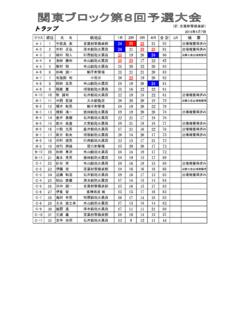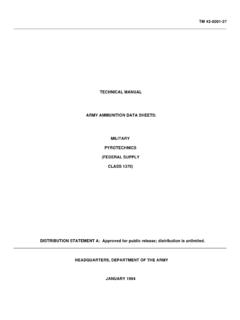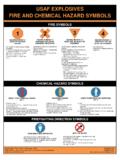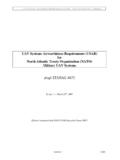Transcription of Fact Sheet MANAGING VULTURE DAMAGE IN PENNSYLVANIA
1 United States Department of Agriculture Animal and Plant Health Inspection Service Wildlife Services 1-866-487-3297 Eastern District 152 Schuylkill Mtn. Rd Schuylkill Haven, PA 17972 (570) 739-1216 Fax (717) 236-9454 State Office PO Box 60827 Harrisburg, PA 17106 (717) 236-9451 Fax (717) 236-9454 Western District 4820 Route 711, Suite A Bolivar, PA 15923 (724) 238-7320 Fax (724) 238-7274 _____ Fact Sheet MANAGING VULTURE DAMAGE IN PENNSYLVANIA _____ February 2011 Background The turkey VULTURE (Cathartes aura), a historic resident of PENNSYLVANIA , and the black VULTURE (Coragyps atratus), a recent immigrant, are present in the state throughout the year.
2 Turkey vultures have become increasingly abundant throughout the Northeast and black vultures have extended their range northward into Maryland, Delaware, New Jersey, and PENNSYLVANIA during the past 50 years. Property DAMAGE and nuisance problems have been attributed to both species. Livestock predation problems have been attributed to black vultures, and both species jeopardize aircraft safety when in or around airport environments and are involved in wildlife-aircraft collisions (bird strikes). Identification The turkey VULTURE is the larger of the two species, with an average weight of four pounds and a wingspan up to six feet. It is predominantly dark brown-black with a featherless, bright red (adult) or brown (juvenile) head and a relatively long, narrow tail.
3 The undersides of the wings are gray except along the leading edges, which are black. The black VULTURE weighs less than four pounds and has a wingspan of less than five feet. It is also predominantly black including a dark gray to black head (juvenile and adult). The tail is shorter and wider (fanned) than that of the turkey VULTURE . The undersides of Turkey VULTURE 2the wings are dark gray with large white patches near the wing tips. Turkey vultures have been reported to live up to 16 years of age and black vultures up to 25 years. Legal Status Turkey vultures and black vultures are federally protected by the Migratory Bird Treaty Act, administered by the Fish and Wildlife Service.
4 Both black and turkey vultures are protected non-game birds in PENNSYLVANIA . In order to trap, kill, relocate, or otherwise handle a VULTURE or its eggs, a Federal permit is required. A permit application may be obtained by calling the USFWS Regional Migratory Bird Permit Office: PO Box 779, Hadley, MA 01035-0779; Telephone (413) 253-8643. Federal and State permit applications are available from USDA APHIS Wildlife Services program (address above). General Biology Although vultures occasionally prey on domestic fowl and livestock, they feed primarily on carrion and have adapted to specialize in scavenging carcasses. They have keen eyesight and highly developed sense of smell compared with other bird species.
5 Vultures have strong bills for pulling and tearing, but relatively weak feet, making it difficult to lift or carry much. These birds do not build nests, but lay their eggs in dense thickets, in hollow logs, on rock ledges, in caves and even in abandoned buildings. Usually two eggs are laid and these hatch in approximately 40 days. Adults care for young for about 3 months. Vultures congregate in large communal roosts typically located in wooded hollows or ravines with drainages into lakes or rivers. Occasionally vultures roost in backyard trees, in town, or even on suburban rooftops. These roosts are used throughout the year but are largest during the late autumn through early spring.
6 Roosts are dynamic and vultures may use different roost sites each night. Black vultures and turkey vultures may roost together. Occasionally, vultures can be observed roosting on water towers or radio/microwave towers. DAMAGE Nuisance and property DAMAGE problems involving turkey vultures and black vultures include unwanted congregations of these birds around areas of human activity (homes, schools, churches, shopping areas) resulting in accumulations of feces on trees and lawns, residential and commercial buildings, electrical and radio transmission towers, and other structures. Accumulations of droppings can result in unpleasant odors emanating from roost sites. Accumulations on electrical transmission towers have resulted in arcing and localized power outages.
7 Public water supplies have been contaminated with fecal coliform bacteria as a result of droppings entering water towers, springs, or other sources. Other property DAMAGE attributed to vultures includes tearing, and sometimes consuming, asphalt shingles and rubber roofing material, rubber, vinyl, or leather upholstery from cars, boats, tractors, and other vehicles, latex window caulking, and plastic flowers at cemeteries. Most DAMAGE of this type is attributed to black vultures, although turkey Black VULTURE 3vultures have been implicated in some situations. DAMAGE to livestock by black vultures may involve plucking the eyes and eating the tongues of newborn, down, or sick livestock, disemboweling young livestock, killing and feeding on domestic fowl, and general flesh wounds from bites.
8 Concentrations of vultures can be hazardous to aircraft, especially when sanitary landfills are situated in close proximity to flight paths at airports DAMAGE Control Methods As is the case with all wildlife DAMAGE problems, the best approach is to consider and apply a number of safe, effective, legal and practical techniques and methods. An integrated VULTURE DAMAGE management program may include habitat management, harassment, and/or population management. Habitat Management The elimination of VULTURE food, roost trees, and nest sites will reduce the number of birds in the area. Clean farming practices that include prompt carcass disposal (burial, incineration, etc.) and protected lambing/calving will reduce available food sources.
9 Black vultures are often attracted by and feed on placentas before damaging a newborn calf or lamb. The scent of afterbirth can attract vultures from a great distance. Disposal of afterbirth, to the extent possible, will help to reduce this attraction. Where vultures are creating nuisance and property DAMAGE problems by perching on rooftops, installation of a wire pulled taut about 8" above and parallel to the ridgeline of the roof will discourage or prevent birds from perching. It is important to maintain a high tension on the wire so that vultures cannot push it down, and to maintain the correct height above the ridgeline so they cannot straddle or perch beneath it. The use of tactile repellents such as Tanglefoot, Roost-no-more, or double-sided tape may discourage perching in situations where wire installation is not possible or practical.
10 Barriers such as overhead monofilament grid lines and netting may also be used to exclude vultures from protected areas. Although extreme, removal of roost site trees and pruning of branches will induce birds to abandon a traditional roost site. Harassment (Also see Special Notes Page 5) Vultures may be harassed away from an area with the use of pyrotechnics fired from a 15-millimeter launcher (starter pistol); shell crackers fired from a 12-gauge shotgun or, propane cannons. Prior to initiating a harassment program, consult your state and local laws regarding the possession and use of firearms and pyrotechnic launchers, and review firearm discharge, noise and bird sanctuary ordinances.





